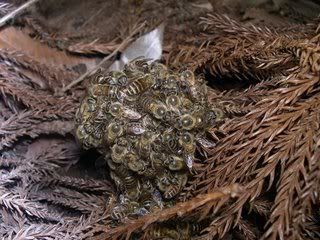Life ain't easy. There's always a threat lurking around the corner, whether you're a human or a bacteria. Therefore, there are as many defence mechanisms as there are species (if not more!). The poor Japanese honeybees (Apis cerana japonica) are subject of the giant hornet (Vespa mandarinia japonica), who - upon finding and entering a honeybee nest - will destroy it and take the honeybee broods to feed their own larvae. Brutal! In Homo sapien conflicts, destruction of villages and cities are known throughout history but I've never heard of soldiers taking babys to feed their own.
Of course, since evolution is as magnificent as it is, the honeybees have evolved a defence mechanism and it is just as brutaly remarkable as the hornets attack. When the hornet arrives to a nest and marks it (with a pheromone), guard bees starts to send out signals (also pheromones) that makes all bees near the entrance to retreat into the nest. Then, more than 1000 worker bees gather just outside the entrance, and if a hornet tries to enter, the workers form a huge ball that surrounds the intruder. The hornet becomes marked with venom and secretion so that all workers knows that they should focus their attack energy on it. The most brutal thing is how the hornet is finally destroyed: the swarm around it generates a lot of heat (it can reach up to 47 degrees C) so it is basically roasted to death. Now, how's that for a defence!
 Image revised from http://sequentialscribbles.blogspot.com/2008/01/and-you-thought-wasps-were-bastards.html
Image revised from http://sequentialscribbles.blogspot.com/2008/01/and-you-thought-wasps-were-bastards.html
Source:
Pheromones and animal behaviour : communication by smell and taste (book)
by Wyatt Tristam
 Image revised from http://sequentialscribbles.blogspot.com/2008/01/and-you-thought-wasps-were-bastards.html
Image revised from http://sequentialscribbles.blogspot.com/2008/01/and-you-thought-wasps-were-bastards.htmlSource:
Pheromones and animal behaviour : communication by smell and taste (book)
by Wyatt Tristam



Inga kommentarer:
Skicka en kommentar